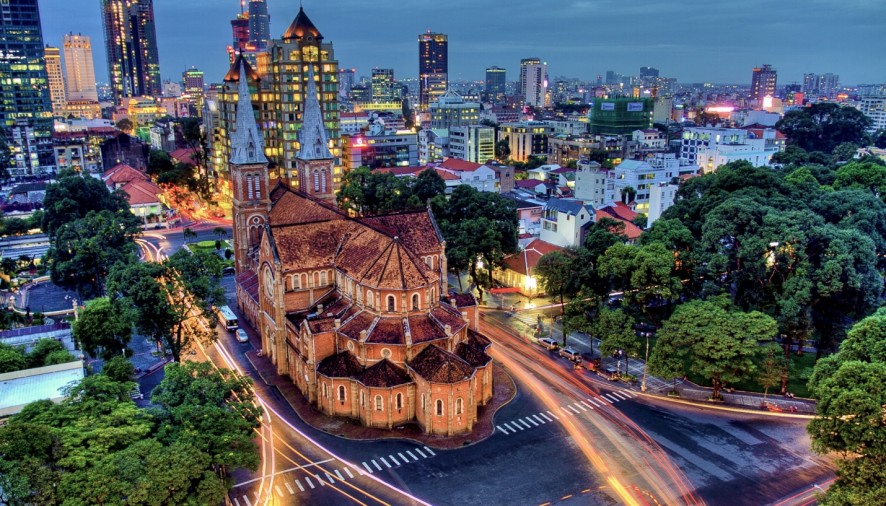After immersing myself in all things Graham Greene during a module for my English Literature M.A. at the University of Leeds earlier this year, I could not resist seeking out the memorable locations featured in The Quiet American, during a recent trip to Ho Chi Minh City.
I step onto the former rue Catinet (now the Dong Khoi), and there is an unmistakable whiff of a cherry flavoured vape pen. Chinese tourists take turns taking selfies outside the opera house, and taxis arm wrestle each other for space on the tarmac. It’s fair to say that it’s not just the name of Saigon that changed greatly since Graham Greene was stationed there four times as a foreign correspondent in the early 1950s. Greene is a master of location. He is the great literary chameleon of the 20th century. From Havana to Haiti, Switzerland to Sierra Leone. He had an ability to present identifiably Graham Greene novels across a dizzying array of places. The Quiet American is arguably his most celebrated and his most potent. It follows the story of Thomas Fowler; a world worn British journalist stationed in the current Ho Chi Minh City. He meets the enigmatic, naïve and dangerous Pyle – an American with murky intentions. But like so many of Greene’s texts it is the location that is the biggest enigma. Greene’s Saigon is one of champagne with the ambassador by day and opium dens and brothels by night. On paper it’s intoxicating. As the city mutates at a rapid rate, with construction projects on seemingly every corner, many of the locations of Greene’s classic still stand.
We memorably first meet Pyle as he lays dead ‘in the water under the bridge to Dakow’. The original Dakow bridge of Greene’s era was unfortunately dismantled and rebuilt with something a bit more fitting for the endless stream of motorbikes and VinaSun taxis that hurtle across the river. Gladly, the place is still reassuringly grim.
Greene’s favourite hotel was the Continental, and he would regularly stay in room 214 – which offers the perfect vantage point onto the Place Garnier (Lam So’n Square). I settle for a spot on the third floor of a nearby coffee house, and take advantage of the free Wi-Fi. I spent a good twenty minutes being amused by the street hawkers below hassling bushy tailed tourists – and witness varying degrees of comical and awkward meetings.
Built in 1880, Notre-Dame stands like a headstone to the French influence upon the city. Greene pithily dubs it the ‘hideous pink cathedral’ which puts an abrupt full stop to the Rue Catinet that he enjoyed so much. I think that’s a touch harsh. It’s a fine sight that will always remain pleasingly jarring amongst the Asian metropole.
The old police station where Inspector Vigot undertakes his investigation into Pyle’s murder is still here, though today houses the admittedly less sexy government department for culture, sports and tourism. Fowler remarks that the place smells of ‘urine and injustice. And yet that too was part of home, like the dark passages one avoided in childhood’. In his exploration of location Greene is drawn to the darkness like the reverse moth to a flame.
Next is the former Grands Magasin Charter, or the ‘big store at the corner of the Boulevard Charnier’. The theme of Quiet American locations now housing supremely unglamorous offices continues, as up until 2014 it was a building for tax affairs. Outside Fowler witnesses Operation Bicyclelette, where all over Saigon ‘innocent bicycle-pumps had proved to be plastic bombs’. ‘Nobody was hurt’ remarks Fowler with a tinge of regret. The statue of Ho Chi Minh watches on impassively. I meet a German man who sees me holding the book and enthusiastically talks of how he has spent the last few evenings reading the book in his hotel room. Nearby street sellers hawk copies of the novel alongside Dan Brown and Harry Potter. Like The Beach and Thailand, The Quiet American has entered rite of passage status amongst travellers to Vietnam.
Below is the first American Embassy in the city, and Pyle’s place of work, the elusive ‘American Legation’ where Pyle frustratingly encounters a wall of beaurocracy when he tries to confront Pyle about his relationship with Fowler’s Vietnamese mistress, Phong.
It is thirsty work reading the booze soaked fictions of Graham Greene. So I thought it would be fitting to drink something fizzy at the rooftop bar of the Majestic, Fowler’s favourite haunt. The romance of his description still lingers – ‘it would ever be seven o’clock and cocktail-time on the roof of the Majestic, with a wind from the Saigon River’. Wind would be blessed relief on a oppressively humid August afternoon, but the alcohol works.
The next stop on my trip is to the mountain town of Dalat, which Greene describes in The Quiet American as being ‘the nearest he could get to the atmosphere of the English lakes’. And so the search for Graham Greene is never quite over…
Thomas Barrett
Image: crossingtravel.com

